Siege of Nice facts for kids
The Siege of Nice happened in 1543. It was a big event during the Italian War of 1542–46. In this war, King Francis I of France and Suleiman the Magnificent, the leader of the Ottoman Empire, worked together. They formed an alliance against their common enemy, Charles V, who was the Holy Roman Emperor. At this time, Nice was controlled by Charles III, Duke of Savoy, who was an ally of Charles V. This siege was also part of a larger naval campaign by the famous Ottoman admiral, Hayreddin Barbarossa.
Quick facts for kids Siege of Nice |
|||||
|---|---|---|---|---|---|
| Part of the Italian War of 1542–46 | |||||
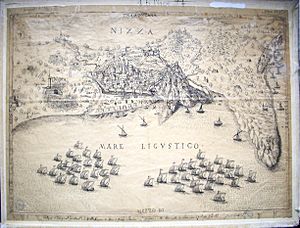 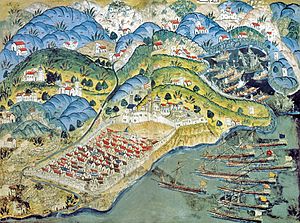 Top: In the siege of Nice in 1543, a combined Franco-Ottoman force captured the city. Bottom: Ottoman depiction of the siege of Nice by Matrakçı Nasuh. |
|||||
|
|||||
| Belligerents | |||||
| Commanders and leaders | |||||
| Strength | |||||
| Casualties and losses | |||||
| 5,000 captives. | |||||
Contents
Why the Siege Happened
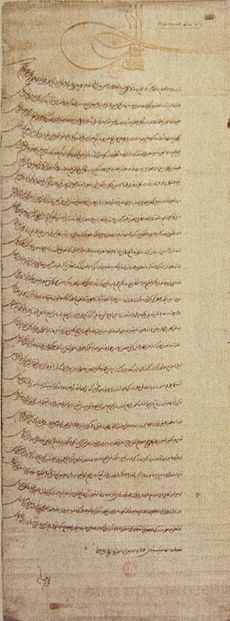
France and the Ottoman Empire worked together closely at sea. This was to fight against the Spanish forces. King Francis I of France asked for this help.
The French forces were led by François de Bourbon. The Ottoman forces were led by Hayreddin Barbarossa. They first met in Marseille in August 1543.
Nice was part of the Duchy of Savoy. This area had been under French protection for about 100 years. However, King Francis I decided to attack Nice with his allies. This was because Duke Charles III had made him angry. Charles III had married Beatrice of Portugal. This made him an ally of the Habsburgs, who were enemies of France.
François de Bourbon had tried to surprise attack Nice before. But he was stopped by Andrea Doria, a famous admiral.
The Ottoman Fleet Arrives
King Francis I and Suleyman the Magnificent made an agreement. The French ambassador in Constantinople, named Captain Polin, helped with this. A large fleet of 110 ships, called galleys, left from the Sea of Marmara. This fleet was led by Hayreddin Barbarossa.
In June, Barbarossa's fleet raided the coasts of Sicily and Southern Italy. On June 29, they anchored near Rome. Ambassador Polin sent messages to assure everyone that Rome would not be attacked.
Barbarossa and his fleet, along with Ambassador Polin, reached Île Saint-Honorat on July 5. France was not fully ready to help the Ottoman fleet. So, Polin went to meet King Francis I to ask for support.
Meanwhile, Barbarossa went to the port of Toulon on July 10. He was then welcomed with honors at the port of Marseille on July 21. There, he met the French forces led by François de Bourbon. The combined French and Ottoman fleet sailed from Marseille on August 5.
The Attack on Nice

The Ottoman forces first landed at Villefranche. This town is about 6 kilometers east of Nice. They captured and destroyed Villefranche.
Then, the French and Ottoman forces worked together to attack the city of Nice. This happened on August 6, 1543. About 110 Ottoman galleys joined with 50 French galleys in this attack.
The people defending Nice fought back very strongly. This led to the famous story of Catherine Ségurane. There was a major battle on August 15. The city of Nice finally surrendered on August 22.
The French stopped the Ottomans from completely looting the city. However, they could not capture the castle, which was called the "Château de Cimiez". It seems the French could not give enough gunpowder to their Ottoman allies for this.

Another important battle against the castle happened on September 8. But the attacking forces eventually left. They heard that an army was coming to help Nice. Duke Charles III had gathered an army in Piedmont to free the city.
Some reports say that on the last night before leaving, Barbarossa looted parts of the city. He also burned some areas and took 5,000 people captive. The relief army arrived by ships led by Andrea Doria. They landed at Villefranche and successfully reached the Nice citadel. However, Spanish records say it was the French who burned the town. A French Marshal named Vieilleville said that Barbarossa and his troops were already gone when the burning happened. He suggested it was blamed on Barbarossa to protect France's reputation.
During the campaign, Barbarossa complained about the French ships. He said they were not well-equipped. He famously asked, "Are you seamen to fill your casks with wine rather than powder?"
The Story of Catherine Ségurane
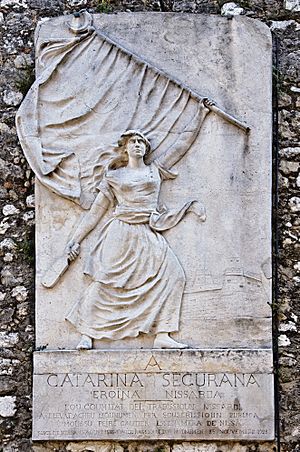
Catherine Ségurane is a local hero from Nice. People say she played a very important role in defending the city during the 1543 siege. At that time, Nice was part of Savoy and was not part of France. It did not have a regular army to defend itself.
Most stories say that Catherine Ségurane was a common washerwoman. She led the townspeople into battle. Legend says she knocked out an enemy flag-bearer with her laundry beater and took his flag.
It is not certain if Catherine really existed or if her heroic actions happened exactly as told. A historian named Jean Badat, who saw the siege, did not mention her. Historically, the townspeople did destroy a key bridge. Also, an army led by Duke Charles III arrived to help.
However, the legend of Catherine Ségurane has inspired many people in Nice. Poems and plays have been written about her. In 1923, a monument was built for her near where her heroic act supposedly happened. In Nice, Catherine Segurane Day is celebrated every year on November 25.
Ottoman Fleet Stays in Toulon

After the siege, King Francis I offered the Ottomans a place to stay for the winter. They stayed in Toulon, a French port. This allowed them to keep attacking the Holy Roman Empire, especially the coasts of Spain and Italy.
The Ottoman fleet had 110 galleys and 30,000 soldiers. They used Toulon as a base to attack Spanish and Italian coasts. They raided Barcelona in Spain and several towns in Italy. They also defeated naval attacks by Italian and Spanish forces.
Barbarossa sailed his fleet to Genoa. There, he talked with Andrea Doria to get Turgut Reis released. France provided a lot of bread to feed the Ottoman army during their six months in Toulon. They also supplied them for their return journey.
It seems King Francis I was not fully committed to this alliance with the Ottomans. Many European powers complained about a Christian country allying with the Ottoman Empire. Relations between the two allies remained tense and suspicious.
What Happened Next
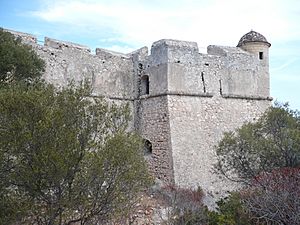
A peace treaty between France and the Habsburgs was signed in Crépy on September 18, 1544. A truce was also signed between the Habsburgs and the Ottomans on November 10, 1545. Emperor Charles V agreed to accept the new lands the Ottomans had conquered. A formal peace treaty was signed on June 13, 1547, after King Francis I had died.
One important local result of the siege was that the coast's defenses were made much stronger. New fortifications were built, especially the castles of Nice and Mont Alban, and the fort of Saint-Elme de Villefranche.
See also
 In Spanish: Sitio de Niza (1543) para niños
In Spanish: Sitio de Niza (1543) para niños
- Orientalism in early modern France
Images for kids
-
Ottoman landing in Villefranche




